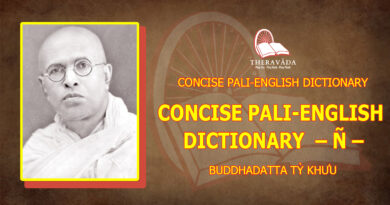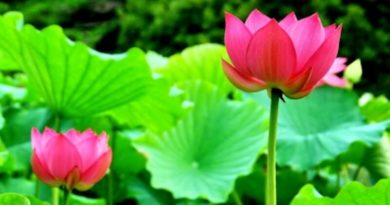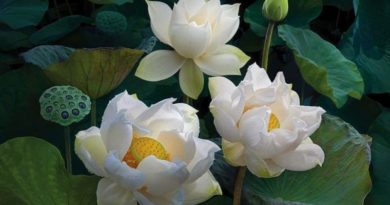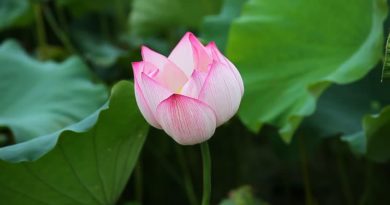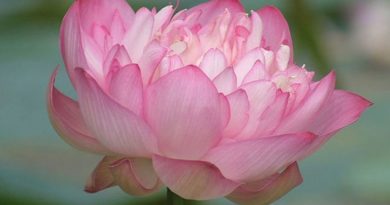ABHIDHAMMA IN DAILY LIFE – CHAPTER 1: THE FOUR PARAMATTHA DHAMMAS
ABHIDHAMMA IN DAILY LIFE – CHAPTER 1: THE FOUR PARAMATTHA DHAMMAS
There are two kinds of reality: mental phenomena (nama) and physical phenomena (rupa). Nama experiences something; rupa does not experience anything. Seeing is, for example, a type of nama; it experiences visible object. Visible object itself is rupa; it does not experience anything. What we take for self are only nama and rupa which arise and fall away. The ‘Visuddhimagga’ (‘Path of Purity’, a commentary) explains (Ch. XVIII, 25):
For this has been said:
– ‘As with the assembly of parts.
The word “chariot” is countenanced,
So, When the khandhas are present,
‘A being’ is said in common usage’
(Kindred Sayings I, 135).
The five khandhas (aggregates) are nothing else but nama and rupa. (See Ch.2.) … So in many hundred suttas there is only mentality-materiality which is illustrated, not a being, not a person. Therefore, just as when the component parts (of a chariot) such as axles, wheels, frame, poles…
are arranged in a certain way, there comes to be the mere conventional term ‘chariot’, yet in the ultimate sense, when each part is examined, there is no chariot, …so too,… there comes to be the mere conventional term ‘a being’, ‘a person’, yet in the ultimate sense, when each component is examined, there is no being as a basis for the assumption ‘ I am’ or ‘ I ‘ ; in the ultimate sense there is only mentality-materiality. The vision of one who sees in this way is called correct vision.
All phenomena in and around ourselves are only nama and rupa which arise and fall away; they are impermanent. Nama and rupa are absolute realities, in Pali: paramattha dhammas. We can experience their characteristics when they appear, no matter how we name them. Those who have developed ‘insight’ can experience them as they really are: impermanent and not self. The more we know different namas and rupas by experiencing their characteristics, the more we will see that ‘self’ is only a concept; it is not a paramattha dhamma.
Nama and rupa are different types of realities. If we do not distinguish them from each other and learn the characteristic of each we will continue to take them for self. For example, hearing is nama; it has no form or shape. Hearing is different from ear-sense, but it has ear-sense as a necessary condition. The nama which hears experiences sound. Ear-sense and sound are rupas, which do not experience anything; they are entirely different from the nama which hears. If we do not learn that hearing, ear-sense and sound are realities which are altogether different from each other, we will continue to think that it is self which hears.
The ‘Visuddhimagga’ (XVIII, 34) explains:
Furthermore, nama has no efficient power, it cannot occur by its own efficient power… It does not eat, it does not drink, it does not speak, it does not adopt postures. And rupa is without efficient power; it cannot occur by its own efficient power. For it has no desire to eat, it has no desire to drink, it has no desire to speak, it has no desire to adopt postures. But rather it is when supported by rupa that nama occurs; and it is when supported by nama that rupa occurs. When nama has the desire to eat, the desire to drink, the desire to speak, the desire to adopt a posture, it is rupa that eats, drinks, speaks and adopts a posture….
Furthermore (XVIII, 36) we read:
And just as men depend upon
A boat for traversing the sea,
So does the mental body need
The matter-body for occurrence.
And as the boat depends upon
The men for traversing the sea,
So does the matter-body need
The mental body for occurrence.
Depending each upon the other
The boat and men go on the sea.
And so do mind and matter both
Depend the one upon the other.
There are two kinds of conditioned nama: citta (consciousness) and cetasika (mental factors arising together with consciousness). They are namas which arise because of conditions and fall away again.
As regards citta, citta knows or experiences an object. Each citta must have its object of knowing, in Pali: arammana. The citta which sees has what is visible as its object. The citta which hears (hearing-consciousness) has sound as its object. There isn’t any citta without an object (arammana). Even when we are sound asleep, citta experiences an object. There are many different types of citta which can be classified in different ways.
Some cittas are akusala (unwholesome), some are kusala (wholesome). Akusala cittas and kusala cittas are cittas which are causes. They can motivate unwholesome or wholesome deeds through body, speech or mind. Some cittas are vipakacittas, the result of unwholesome or wholesome deeds. Some cittas are kiriyacittas neither cause nor result.
Cittas can be classified by way of jati’ (literally means ‘birth’ or ‘nature’). There are four jatis: akusala, kusala, vipaka, kiriya.
It is important to know which jati a citta is. We cannot develop wholesomeness in our life if we take akusala for kusala or if we take akusala for vipaka. For instance, when we hear unpleasant words, the moment of experiencing the sound (hearing-consciousness) is akusala vipaka, the result of an unwholesome deed we performed ourselves. But the aversion which may arise very shortly afterwards is not vipaka, but it arises with akusala citta.
Another way of classifying citta is by plane of consciousness (bhumi). There are four different planes of consciousness: kamavacara citta, rupavacara citta, arupavacara citta, lokuttara citta.
The sensuous plane of consciousness (kamavacara cittas) is the plane of sense-impressions, for examples: seeing, hearing, smelling, tasting and receiving impressions through the body-sense. There are other planes of citta which do not experience sense-impressions. Those who cultivate samatha (tranquil meditation) and attain absorption (jhana), have jhanacittas. The jhanacitta is another plane of citta; it does not experience sense-impressions. The lokuttara citta (‘supramundane’ consciousness) is the highest plane of consciousness because it is the citta which directly experiences nibbana.
There are still other ways of classifying citta and if we consider the different intensities of citta there are many more differences between cittas. For instance, akusala cittas, which are rooted in lobha (attachment), dosa (aversion) and moha (ignorance), can be of many different intensities. Sometimes they may motivate deeds, sometimes they may not, depending on the degree of akusala. Kusala cittas too are of many different intensities.
There are altogether eighty-nine or one hundred and twenty-one types of citta. The classification by way of a hundred and twenty-one types includes the cittas of the ariyans who cultivated both jhana (absorption) and vipassana and who could experience nibbana with absorption.
The second paramattha dhamma is cetasika which is nama. As we have seen, citta experiences an object: seeing has what is visible as its object, hearing has sound as its object, thinking has what is thought about as its object. However, there is not only citta, there are also mental factors, cetasikas, which accompany a citta. One can think of something with aversion, with a pleasant feeling, with wisdom. Aversion, feeling and wisdom are mental phenomena which are not citta; they are cetasikas which accompany different cittas. There is only one citta at a time, but there are several cetasikas (at least seven) arising together with the citta and falling away together with the citta, citta never arises alone. For example, feeling, in Pali: vedana, is a cetasika which arises with every citta. Citta only knows or experiences its object; it does not feel. Vedana, however, has the function of feeling. Feeling is sometimes pleasant, sometimes unpleasant. When we do not have a pleasant or an unpleasant feeling, there is still feeling: at that moment the feeling is neutral or indifferent. There is always feeling; there isn’t any moment of citta without feeling. For example, when seeing-consciousness arises, feeling (vedana) arises together with the citta. The citta which sees perceives only visible object; there is not yet like or dislike. The feeling which accompanies this type of citta is indifferent feeling. After seeing-consciousness has fallen away, other cittas arise and there may be cittas which dislike the object. The feeling which accompanies this type of citta is unpleasant feeling.
The function of citta is to cognize an object; citta is the ‘chief in knowing’. Cetasikas share the same object with the citta, but they each have their own specific quality and function. There are altogether fifty-two kinds of cetasika. There are seven kinds of cetasika which arise with every citta; the other kinds do not arise with every citta.
Perception, in Pali: sanna, is a cetasika which arises with every citta. In the ‘Visuddhimagga’ (XIV,130) we read about sanna that it has the characteristic of perceiving:
…Its function is to make a sign as a condition for perceiving again that ‘this is the same’, as carpenters, etc., do in the case of timber…
Citta only experiences an object; it does not ‘mark’ its object. It is sanna (perception) which marks the object which is experienced so that it can be recognized later on. Whenever we remember things it is sanna and not self which remembers. It is sanna which, for example, remembers that this colour is red, that this is a house, or that this is the sound of a bird
Cetana, (intention), is another kind of cetasika which arises with every citta. There are types of cetasika which do not arise with every citta. Akusala (unwholesome) cetasikas arise only with akusala cittas. Sobhana (beautiful) cetasikas arise with wholesome cittas. (See Ch.19)
Lobha (attachment), dosa (aversion) and moha (ignorance) are akusala cetasikas which arise only with akusala cittas. For example, when we see something beautiful, cittas with attachment to what we have seen may arise. The cetasika which is lobha arises with the citta at that moment. Lobha has the function of attachment or clinging. There are several other akusala cetasikas which arise with akusala cittas, such as conceit (mana), wrong view (ditthi) and envy (issa).
Sobhana (beautiful) cetasikas accompanying wholesome cittas are, for example alobha (generosity), adosa (lovingkindness), panna (or amoha). When we are generous, alobha and adosa arise with the kusala citta, sanna may arise too with the kusala citta; and there are other kinds of sobhana cetasikas arising with the wholesome citta as well.
Although citta and cetasika are both nama, they each have different qualities. One may wonder how cetasikas can be experienced. When we notice a change in citta, a characteristic of cetasika can be experienced. For instance, when akusala cittas with stinginess arise after kusala cittas with generosity have fallen away, we can notice a change. Stinginess and generosity are cetasikas which can be experienced; they have different characteristics. We may notice as well the change from attachment to aversion, from pleasant feeling to unpleasant feeling. Feeling is a cetasika we can experience, because feeling is sometimes predominant and there are different kinds of feeling. We can experience that unpleasant feeling is different from pleasant and neutral feeling. These different cetasikas arise with different cittas and they fall away immediately, together with the citta they accompany. If we know more about the variety of citta and cetasika, it will help us to see the truth.
There are not only mental phenomena, there are also physical phenomena. Physical phenomena (rupa) are the third paramattha dhamma. There are altogether twenty-eight classes of rupa. There are four principal rupas or ‘Great Elements’, in Pali: maha-bhuta-rupa. They are:
- ‘Element of Earth’ or solidity (to be experienced as hardness or softness)
2. ‘Element of Water’ or cohesion
3. ‘Element of Fire’ or temperature (to be experienced as heat or cold)
4. ‘Element of Wind’ or motion (to be experienced as motion or pressure)
These ‘Great Elements’ arise together with all the other kinds of rupa, in Pali: upada-rupa. Rupas never arise alone. They arise in ‘groups’ or ‘units’. There have to be at least eight kinds of rupa arising together. For example, whenever the rupa which is temperature arises, solidity, cohesion, motion and other rupas arise as well. Upada-rupas are, for examples, the physical sense-organs of eye-sense, ear-sense, smelling-sense, tasting-sense and body-sense, and the sense-objects of visible object, sound, odour and flavour.
Different characteristics of rupa can be experienced through eyes, ears, nose, tongue, body-sense and mind. These characteristics are real since they can be experienced. We use conventional terms such as ‘body’ and ‘table’; both have the characteristic of hardness which can be experienced through touch. In this way we can prove that the characteristic of hardness is the same, no matter whether it is in the body or in the table. Hardness is a paramattha dhamma; ‘body’ and ‘table’ are not paramattha dhammas but only concepts. We take it for granted that the body stays and we take it for self, but what we call ‘body’ are only different rupas arising and falling away. The conventional term ‘body’ may delude us about reality. We will know the truth if we learn to experience different characteristics of rupa when they appear.
Citta, cetasika and rupa only arise when there are the right conditions, they are conditioned dhammas (in Pali: sankhara dhamma). Seeing cannot arise when there is no eye-sense and when there is no visible object. Sound can only arise when there are the right conditions for its arising. When it has arisen it falls away again. Everything which arises because of conditions has to fall away again when the conditions have ceased. One may think that sound stays, but what we take for a long, lasting moment of sound is actually many different rupas succeeding one another.
The fourth paramattha dhamma is nibbana. Nibbana is the end of defilements. Nibbana can be experienced through the mind-door if one follows the right Path leading towards it: the development of the wisdom which sees things as they are. Nibbana is nama. However, it is not citta or cetasika. Nibbbna is the nama which does not arise and fall away; it is the nama which is an unconditioned reality (in Pali:visankhara dhamma). It does not arise, because it is unconditioned and therefore it does not fall away. Citta and cetasika are namas which experience an object; nibbana is the nama which does not experience an object, but nibbana itself can be the object of citta and cetasika which experience it, Nibbana is not a person, it is not-self; it is anatta.
Summarizing the four paramattha dhammas, they are:
| 1. citta 2. cetasika 3. rupa |
conditioned dhammas (sankhara dhamma) |
| 4. nibbana | unconditioned dhamma (visankhara dhamma) |
When we study Dhamma it is essential to know which paramattha dhamma such or such reality is. If we do not know this we may be misled by conventional terms. We should, for example know that what we call ‘body’ are actually different rupa-paramattha dhammas, not citta or cetasika. We should know that nibbana is not citta or cetasika, but the fourth paramattha dhamma. Nibbana is the end of all conditioned realities. When an arahat, passes away, there is no more rebirth for him.
All conditioned dhammas: citta, cetasika and rupa, are impermanent (anicca). All conditioned dhammas are ‘dukkha’ since they are impermanent.
All dhammas are anatta, not-self (in Pali: sabbe dhamma anatta). Thus, the conditioned dhammas are impermanent and dukkha. But all dhammas, that is, the four paramattha dhammas, nibbana included, have the characteristic of anatta, not-self.
-ooOoo-
Questions
- What is the difference between nama and rupa?
2. What is the difference between citta and cetasika?
3. Do cetasikas experience an object?
4. Is there more than one cetasika arising together with the citta?
5. Can nibbana experience an object?
6. Is nibbana a ‘self’?

